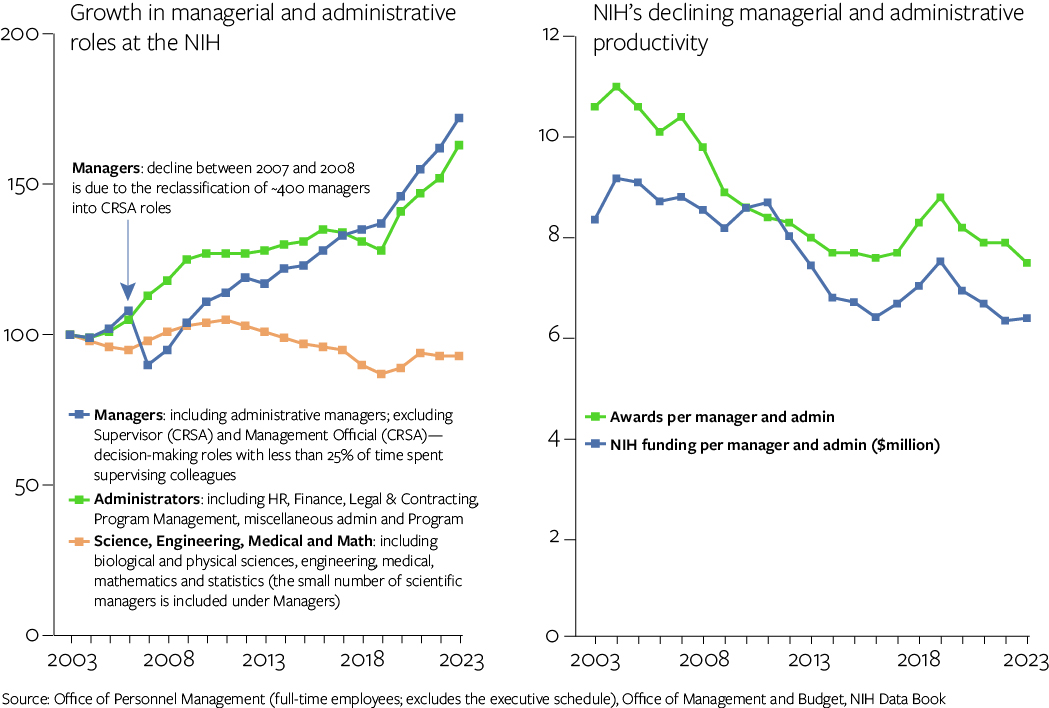
Measuring Research Bureaucracy to Boost Scientific Efficiency and Innovation
Bureaucracy has become a critical barrier to scientific progress in America. An excess of management and administration efforts pulls researchers away from their core scientific work and consumes resources that could advance discovery. While we lack systematic measures of this inefficiency, the available data is troubling: researchers spend nearly half their time on administrative tasks, and nearly one in five dollars of university research budgets goes to regulatory compliance.
The proposed solution is a three-step effort to measure and roll back the bureaucratic burden. First, we need to create a detailed baseline by measuring administrative personnel, management layers, and associated time/costs across government funding agencies and universities receiving grant funding. Second, we need to develop and apply objective criteria to identify specific bureaucratic inefficiencies and potential improvements, based on direct feedback from researchers and administrators nationwide. Third, we need to quantify the benefits of reducing bureaucratic overhead and implement shared strategies to streamline processes, simplify regulations, and ultimately enhance research productivity.
Through this ambitious yet practical initiative, the administration could free up over a million research days annually and redirect billions of dollars toward scientific pursuits that strengthen America’s innovation capacity.
Challenge and Opportunity
Federally funded university scientists spend much of their time navigating procedures and management layers. Scientists, administrators, and policymakers widely agree that bureaucratic burden hampers research productivity and innovation, yet as the National Academy of Sciences noted in 2016 there is “little rigorous analysis or supporting data precisely quantifying the total burden and cost to investigators and research institutions of complying with federal regulations specific to the conduct of federally funded research.” This continues to be the case, despite evidence suggesting that federally funded faculty spend nearly half of their research time on administrative tasks, and nearly one in every five dollars spent on university research goes to regulatory compliance.
Judging by the steady rise in research administration requirements that face universities, the problem is getting worse. Federal rules and policies affecting research have multiplied ninefold in two decades— from 29 in 2004 to 255 in 2024, with half of the increase just in the last five years. It is no coincidence that the bureaucratic overhead is also expanding in funding agencies. At the National Institutes of Health (NIH), for instance, the growth of managers and administrators has significantly outpaced scientific roles and research funding activity (see figure).

The question is: just how much of universities’ $100 billion-plus annual research spend (more than half of it funded by the federal government) is hobbled by excess management and administration? To answer this, we must understand:
- Which bureaucratic activities are wasteful, or have a poor return on time and effort?
- How much time do bureaucratic activities take up, and what is the cost overall?
- Which activities are not required by the law or regulations, but are imposed by overly risk-averse legal counsel, compliance, and other administrators at agencies or universities?
- Which activities, rules, and processes should be eliminated or reimagined, and how?
- What portion of the overhead budget isn’t spent on research administration or management?
Plan of Action
The current administration aims to make government-funded research more efficient and productive. Recently, the director of the Office of Science and Technology Policy (OSTP) vowed to “reduce administrative burdens on federally funded researchers, not bog them down in bureaucratic box checking.” To that end, I propose a systematic effort that measures bureaucratic excess, quantifies the payoff from eliminating specific aspects of this burden, and improves accountability for results.
The president should issue an Executive Order directing the Office of Management and Budget (OMB) and Office of Science and Technology Policy (OSTP) to develop a Bureaucratic Burden report within 180 days of signing. The report should detail specific steps agencies will take to reduce administrative requirements. Agencies must participate in this effort at the leadership level, launching a government-wide effort to reduce bureaucracy. Furthermore, all research agencies should work together to develop a standardized method for calculating burden within both agencies and funded institutes, create a common set of policies that will streamline research processes, and establish clear limits on overhead spending to ensure full transparency in research budgets.
OMB and OSTP should create a cross-agency Research Efficiency Task Force within the National Science and Technology Council to conduct this work. This team would develop a shared approach and lead the data gathering, analysis, and synthesis using consistent measures across agencies. The Task Force’s first step would be to establish a bureaucratic baseline, including a detailed view of the managerial and administrative footprint within federal research agencies and universities that receive research funding, broken down into core components. The measurement approach would certainly vary between government agencies and funding recipients.
Key agencies, including the NIH, National Science Foundation, NASA, the Department of Defense, and the Department of Energy, should:
- Count personnel at each level—managers, administrators, and intramural scientists—along with their compensation;
- Document management layers from executives to frontline staff and supervisor ratios;
- Calculate time spent on administrative work by all staff, including researchers, to estimate total compliance costs and overhead.
- Task Force agencies should also hire an independent contractor(s) to analyze the administrative burden at a representative sample of universities. Through surveys and interviews, they should measure staffing, management structures, researcher time allocation, and overhead costs to size up the bureaucratic footprint across the scientific establishment.
Next, the Task Force should launch an online consultation with researchers and administrators nationwide. Participants could identify wasteful administrative tasks, quantify their time impact, and share examples of efficient practices. In parallel, agency leaders should submit to OMB and OSTP their formal assessment of which bureaucratic requirements can be eliminated, along with projected benefits.
Finally, the Task Force should produce a comprehensive estimate of the total cost of unnecessary bureaucracy and propose specific reforms. Its recommendations will identify potential savings from streamlining agency practices, statutory requirements, and oversight mechanisms. The Task Force should also examine how much overhead funding supports non-research activities, propose ways to redirect these resources to scientific research, and establish metrics and a public dashboard to track progress.
Some of this information may have already been gathered as part of ongoing reorganization efforts, which would expedite the assessment.
Within six months, the group should issue a public report that would include:
- A detailed estimate of the unnecessary costs of research bureaucracy.
- The cost gains from rolling back or adjusting specific burdens.
- A synthesis of harder-to-quantify benefits from these moves, such as faster approval cycles, better decision-making, and less conservatism in research proposals;
- A catalog of innovative research management practices, with a four-year timeline for studying and scaling them.
- A proposed approach for regular tracking and reporting on bureaucratic burden in science.
- A prioritized list of changes that each agency should make, including a clear timeline for making those changes and the estimated cost savings.
These activities would serve as the start of a series of broad reforms by the White House and research funding agencies to improve federal funding policies and practices.
Conclusion
This initiative will build an irrefutable case for reform, provide a roadmap for meaningful improvement, and create real accountability for results. Giving researchers and administrators a voice in reimagining the system they navigate daily will generate better insights and build commitment for change. The potential upside is enormous: millions of research days could be freed from paperwork for lab work, strengthening America’s capacity to innovate and lead the world. With committed leadership, this administration could transform how the US funds and conducts research, delivering maximum scientific return on every federal dollar invested.
This memo produced as part of the Federation of American Scientists and Good Science Project sprint. Find more ideas at Good Science Project x FAS
At a time when universities are already facing intense pressure to re-envision their role in the S&T ecosystem, we encourage NSF to ensure that the ambitious research acceleration remains compatible with their expertise.
FAS CEO Daniel Correa recently spoke with Adam Marblestone and Sam Rodriques, former FAS fellows who developed the idea for FROs and advocated for their use in a 2020 policy memo.
When the U.S. government funds the establishment of a platform for testing hundreds of behavioral interventions on a large diverse population, we will start to better understand the interventions that will have an efficient and lasting impact on health behavior.
Integrating AI tools into healthcare has an immense amount of potential to improve patient outcomes, streamline clinical workflows, and reduce errors and bias.